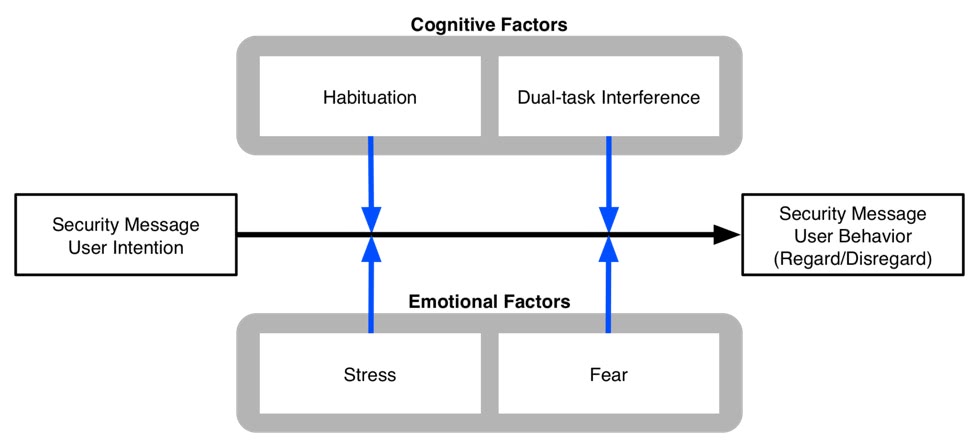Update: The article is now officially published online here.
Our paper entitled, “How Users Perceive and Respond to Security Messages: A NeuroIS Research Agenda and Empirical Study,” was accepted for publication at the European Journal of Information Systems, a leading journal of the field of Information Systems. In our article, we lay out a research agenda for studying security messages using neurophysiological theories and methods.
The purpose of our research agenda is to demonstrate the promise of using neurophysiological measures, and encourage more research in this area. We believe that the approaches described in this article will provide new insights into users’ responses to security messages and facilitate more effective security message designs.
Why Use Neuroscience to Study Security Messages?
Research shows that users routinely disregard security messages. Although users may say that they are concerned about their security, their actual behavior doesn’t match what they say.
The theories and methods of neuroscience provide a promising lens to investigate the disconnect between what users say about security and actually do. The neural bases for human cognitive processes can offer new insights into the complex interaction between information processing and decision making, allowing researchers to open the‘black box’ of cognition by directly observing the brain.
Research Agenda
The figure above shows four factors that we argue interfere with users’ best intentions to comply with security messages: (1) habituation, (2) dual-task interference, (3) stress, and (4) fear. These are not the only important factors, but they are ones that we think the theories and methods of neuroscience have strong potential to address. We briefly describe each below.
How Does Habituation Affect Users’ Responses to Security Messages?
Habituation is the diminishing of attention because of frequent exposure to warnings. Through this process, warnings that were once salient become virtually unnoticeable, like familiar wallpaper. Habituation has been pointed to as a problem in many security-warning studies. However, it is difficult to observe using conventional methods because habituation is a mental state.
Neuroscience approaches can provide additional insight by directly measuring the mental process of habituation to determine (1) how quickly habituation develops in response to security messages, (2) how the neurological manifestation of habituation affects security behaviors, and (3) how long the effects of habituation on security messages persist. As an example, we’ve used fMRI and mouse cursor tracking to study habituation to warnings.
What Is the Impact of Stress on a User’s Response to Security Messages?
Recent research has highlighted the impact of‘technostress’, which is stress caused by interactions with information communication technologies. Stress can have profound detrimental effects on individuals’ productivity and well-being. D’Arcy et al (2014) showed that technostress has important implications for end-user security. An important gap in past stress-related security research is that survey measures capture a user’s perceptions of stress. perceptual measure of stress-inducing conditions, but nothing about the stress that someone is actually experiencing physiologically.
Two neurophysiological methods for measuring stress are cortisol-level measurement and skin conductance response (SCR). Cortisol (commonly called the stress hormone) can measure unconscious stress responses. When an individual’s stress level increases, so does the amount of cortisol in the body as psychological stressors stimulate its release into the bloodstream. Increases in cortisol can be measured easily with a saliva swab that is placed in a capsule for later chemical analysis (see image above).
SCR measures increases in the activity of sweat glands when an individual is stressed, and has been linked to measures of arousal, excitement, fear, etc. By using these and other methods, researchers can measure how users’ stress impacts their responses to security messages.
How Does Fear Influence Our Neural Processing of Security Messages?
Fear can have a powerful impact on how individuals respond to security messages. In information security, both protective and malicious messages commonly attempt to elicit fear to motivate the target into action. However, fear may invoke automatic responses that bypass cognition, leading an individual to not pay attention to a warning. As with stress, past research on fear has relied on survey measures, which don’t measure fear physiologically.
A variety of neurophysiological methods can be used to measure fear. fMRI can measure activation in areas of the brain associated with fear, such as the amygdala, orbitofrontal cortex, and striatum. We propose that facial electromyography (fEMG) is a useful tool to detect fear in users interacting with security messages. With fEMG, visually imperceptible EMG activity in the muscle regions associated with facial expressions (over the brow–corrugator supercilia, eye–orbicularis oculi, and cheek–zygomatic major) can differentiate the intensity and valence of an individual’s reactions to visual stimuli.
How Does Dual-task Interference Disrupt Cognitive Processing of Security Messages?
Dual-task interference (DTI) is a cognitive limitation in which even simple tasks cannot be simultaneously performed without significant performance loss. Responses to security messages are susceptible to DTI because they are typically secondary tasks that interrupt the completion of a users’ primary task of using a computer. Unfortunately, when DTI occurs, performance is reduced for both the primary and secondary tasks, which means that users will not pay full attention to the security warning.
Brain imaging methodologies such as fMRI and electroencephalography (EEG) can be effective techniques for examining the cognitive consequences of DTI. Using EEG, the P300 brainwave component of the event-related potential can be examined, which is associated with attention and memory operations. The P300 reflects brain activity approximately 300–600 milliseconds after exposure to a stimulus. The speed of this measure reveals reaction differences in subjects before they have time to consciously contemplate a response. Monitoring a person’s EEG measures as they perform a computing task that a security message interrupts can allow researchers to see the degree to which the message disrupted the task and the level of cognitive resources devoted to the message. We used EEG in a past study to predict users’ responses to security warnings.
A Call for Research
Neurosecurity has the potential to provide new understanding of how users respond to security messages. We hope researchers will join us in researching the issues described above to significantly advance our understanding of security messages and how to design them to be more effective.
From the abstract:
Users are vital to the information security of organizations. In spite of technical safeguards, users make many critical security decisions. An example is users’ responses to security messages—discrete communication designed to persuade users to either impair or improve their security status. Research shows that although users are highly susceptible to malicious messages (e.g., phishing attacks), they are highly resistant to protective messages such as security warnings. Research is therefore needed to better understand how users perceive and respond to security messages.
In this article, we argue for the potential of NeuroIS—cognitive neuroscience applied to Information Systems—to shed new light on users’ reception of security messages in the areas of (1) habituation, (2) stress, (3) fear, and (4) dual-task interference. We present an illustrative study that shows the value of using NeuroIS to investigate one of our research questions. This example uses eye tracking to gain unique insight into how habituation occurs when people repeatedly view security messages, allowing us to design more effective security messages. Our results indicate that the eye movement-based memory (EMM) effect is a cause of habituation to security messages—phenomenon in which people unconsciously scrutinize stimuli that they have previously seen less than other stimuli. We show that after only a few exposures to a warning, this neurological aspect of habituation sets in rapidly, and continues with further repetitions.
We also created a polymorphic warning that continually updates its appearance and found that it is effective in substantially reducing the rate of habituation as measured by the EMM effect. Our research agenda and empirical example demonstrate the promise of using NeuroIS to gain novel insight into users’ responses to security messages that will encourage more secure user behaviors and facilitate more effective security message designs.


